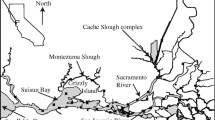Abstract
We present an evaluation of a spatially explicit, age-structured model created to assess fish density dynamics in the Florida Everglades area. This model, ALFISH, has been used to compare alternative management scenarios for the Florida Everglades region. This area is characterized by periodic dry downs and refloodings. ALFISH uses spatially explicit water depth data to predict patterns of fish density. Here we present a method for calibration of ALFISH, based on information concerning fish movement, pond locations and other field data. With the current information, the greatest coefficient of determination achieved from regressions of ALFISH output to field data is 0.35 for fish density and 0.88 for water depth. The poor predictability of fish density mirrors the empirical findings that hydrology, which is the main driver of the model, only accounts for 20–40% of the variance of fish densities across the Everglades landscape. Sensitivity analyses indicate that fish in this system are very sensitive to frequency, size and location of permanent ponds as well as availability of prey.
Similar content being viewed by others
References
Chick, J. H., F. Jordan, J. P. Smith, and C. C. McIvor, 1992. A comparison of four enclosure traps and methods used to sample fishes in aquatic macrophytes. Journal of Freshwater Ecology 7: 353–361.
DeAngelis, D. L., L. J. Gross, M. A. Huston, W. F. Wolff, D. M. Fleming, E. J. Comiskey, and S. M. Sylvester, 1998. Landscape Modeling for Everglades Ecosystem Restoration. Ecosystems 1: 64–75.
DeAngelis, D. L., W. F. Loftus, J. C. Trexler, and R. E. Ulanowicz, 1997. Modeling fish dynamics and effects of stress in a hydrologically pulsed ecosystem. Journal of Aquatic Ecosystem Stress and Recovery 6: 1–13.
Duke-Sylvester, S. and L. J. Gross, 2000. Integrating spatial data into an agentbased modeling system: ideas and lessons from the development of the Across Trophic Level System Simulation (ATLSS). In Gimblett, R. (ed.), Agent-based models and GIS. Oxford, UK, Oxford University Press.
Fasola, M., 1994. Opportunistic use of foraging resources by heron communities in southern Europe. Ecography 17: 113–123.
Gaff, H. D., D. L. DeAngelis, L. J. Gross, R. Salinas, and M. Shorrosh, 2000. A Dynamic Landscape Model for Fish in the Everglades and its Application to Restoration. Ecological Modelling 127: 33–52.
Hof, J. and M. Bevers, 1998. Spatial Optimization for Managed Ecosystems. New York. Columbia University Press.
Jordan, F., S. Coyne, and J. C. Trexler, 1997. Sampling fishes in vegetated habitats: effects of habitat structure on sampling characteristics of the 1-m2 throw trap. Transactions of the American Fisheries Society 126: 1012–1020.
Kushlan, J. A., 1981. Sampling characteristics of enclosure fish traps. Transactions of the American Fisheries Society 110: 557–662.
Loftus, W. F. and A. M. Eklund, 1994. Long-term dynamics of an Everglades small-fish assemblage. In Davis, S. M. and J. C. Ogden (eds.), Everglades: the Ecosystem and its Restoration. Delray Beach, FL, St. Lucie Press.
Loftus, W. F. and J. A. Kushlan, 1987. Freshwater fishes of southern Florida. Bulletin of Florida State Museum: Biological Sciences 31: 147–344.
Odum, E. P., 1969. The strategy of ecosystem development. Science 164: 262–270.
Polis, G. A., 1991. Complex trophic interactions in deserts: an empirical critique of food-web theory. American Naturalist 138: 123–155.
Polis, G. A. and D. R. Strong, 1996. Food web complexity and community dynamics. American Naturalist 147: 813–846.
SAS Institute Inc., 1999. PC-SAS. Version 7.0.
Solow, A. R. and A. R. Beet, 1998. On lumping species in food webs. Ecology 79: 2013–2018.
South Florida Water Management District, 1998. South Florida Water Manage ment Model. http://141.232.1.11/org/pld/restudy/hpm/frame1/sfwmm.htm. (Accessed 11 September 1998).
Trexler, J. C., W. F. Loftus, F. Jordan, J. H. Chick, K. L. Kandle, T. C. McElroy, and O. L. Bass, Jr., 2002. Ecological scale and its implications for freshwater fishes in the Florida Everglades. In Porter, J. W. and K. G. Porter (eds.), The Everglades, Florida Bay, and coral reefs of the Florida Keys: an ecosystem sourcebook. New York, New York, CRC Press.
Trexler, J. C., W. F. Loftus, F. Jordan, J. J. Lorenz, J. H. Chick, and R. M. Lobza, 2000. Empirical assessment of fish introductions in a subtropical wetland: an evaluation of contrasting views. Biological Invasions 2: 265–277.
Turner, A. M., J. C. Trexler, C. F. Jordan, S. J. Slack, P. Geddes, J. H. Chick, and W. F. Loftus, 1999. Targeting ecosystem features for conservation: standing crops in the Florida Everglades. Conservation Biology 13: 898–911.
eis.shtml#mainreport.
Author information
Authors and Affiliations
Rights and permissions
About this article
Cite this article
Gaff, H., Chick, J., Trexler, J. et al. Evaluation of and insights from ALFISH: a spatially explicit, landscape-level simulation of fish populations in the Everglades. Hydrobiologia 520, 73–86 (2004). https://doi.org/10.1023/B:HYDR.0000027728.98923.e7
Issue Date:
DOI: https://doi.org/10.1023/B:HYDR.0000027728.98923.e7




